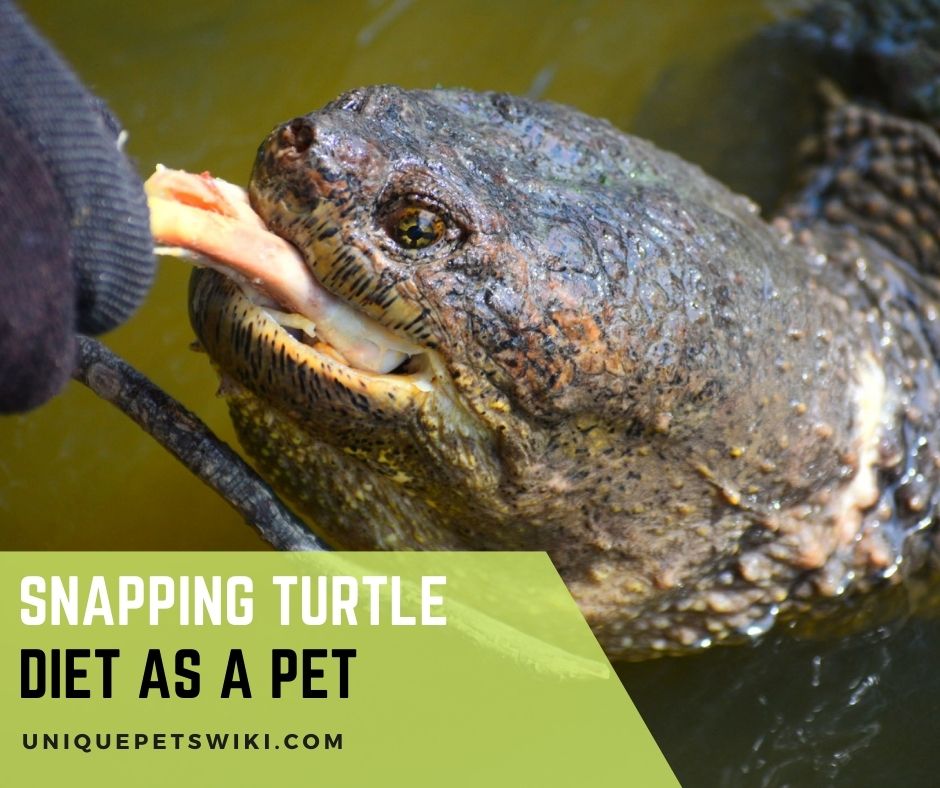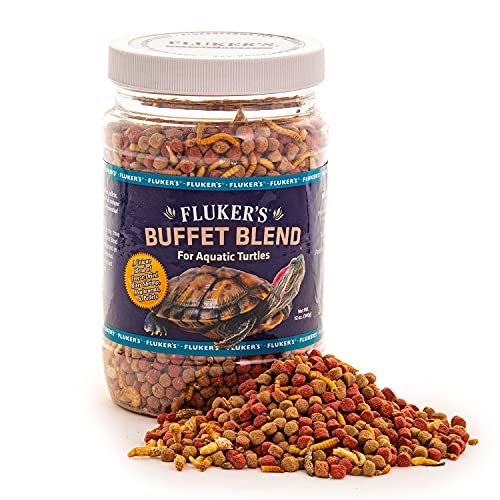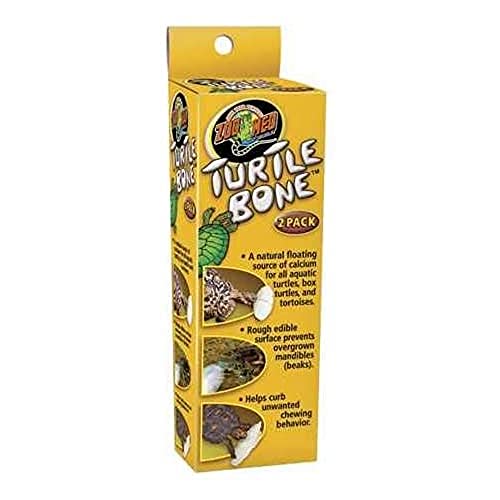In the wild, snapping turtles have a varied diet of birds, fish, frogs, small mammals, and vegetation. But what is the optimum snapping turtle diet as pets?
Are you looking for information pertaining to what snapping turtles should eat in captivity? Then read on, we have all the information you need!
This article has been reviewed by Dr. Gospel. Read more about our knowledge control process here.
Contents
What Do Snapping Turtles Eat in the Wild?
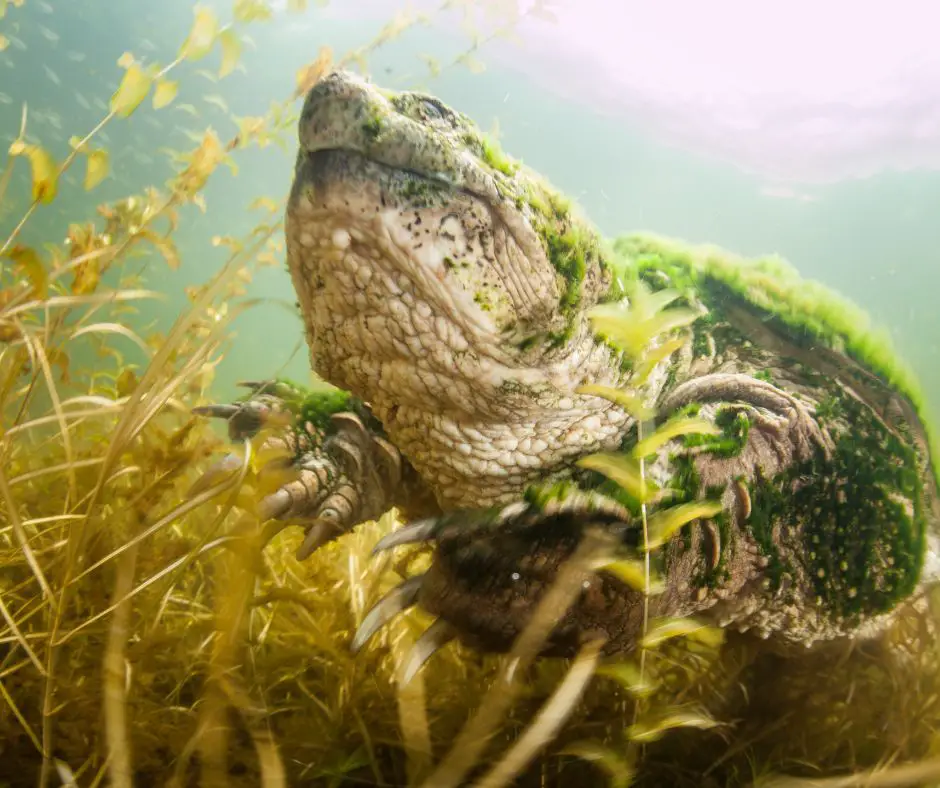
Snapping turtles are omnivores, meaning they eat almost everything.
In the wild, they mainly eat birds, frogs, small mammals, and insects. They also like to eat vegetables, leaves, flowers, and fruit. Worms, snails, crayfish, and other small pests make tasty treats for snapping turtles.
About 30% of a snapping turtle’s diet is vegetation – leaves, moss, algae, vegetables, and flowers, etc. The rest 70% comprises of meat – worms, insects, small mammals, and birds.
They also eat fish, frogs, small turtles, and eggs of other animals.
How Do Snapping Turtles Find Food in the Wild?
Snapping turtles are equipped with long claws that help them dig out insects and worms.
Adult or senior turtles are ambush predators; they dig and bury themselves in the sand along rivers and lakes and patiently wait for their prey. When the prey animal unknowingly walks near the hidden turtle, it attacks them using its strong jaws and sharp claws.
Younger snapping turtles take on a more proactive approach to search for their food. They walk along the shores near lakes and ponds and forage for vegetation and insects along the way.
Despite their slow gait, they can move surprisingly fast when they chance upon prey. They are also equipped with serious power to cause damage to the prey.
Snapping Turtle Diet as A Pet
Your pet snapping turtle diet should ideally mimic the diet it eats in the wild. You need to feed it both animal and plant matter just as they do in the wild. Here are some guidelines to follow when feeding your snapping turtle:
- Snapping turtles are aquatic scavengers. They need a varied diet of fish, frogs, snail, and insects, etc. along with vegetation found in their natural habitats.
- If you have a baby snapping turtle as pet, give it about 3-5 leaves of vegetation. If you feed food pellets, the amount of food pellets that it will take to fill their head. You can adjust the portions and food as your pet grows.
- Juvenile and adult turtles do well on commercial pelleted food. But they also need live food such as snails, fish, worms, and crayfish. You must also feed them some vegetation.
- The carnivorous portion of your turtle’s diet should make no more than 2/3rds of the diet of juveniles and about half of the diet of adult turtle.
Best Food to Feed Snapping Turtles
You must aim to feed your snapping turtle live insects and worms, fish, and lean meat. It also needs vegetables, leaves, and fruit.
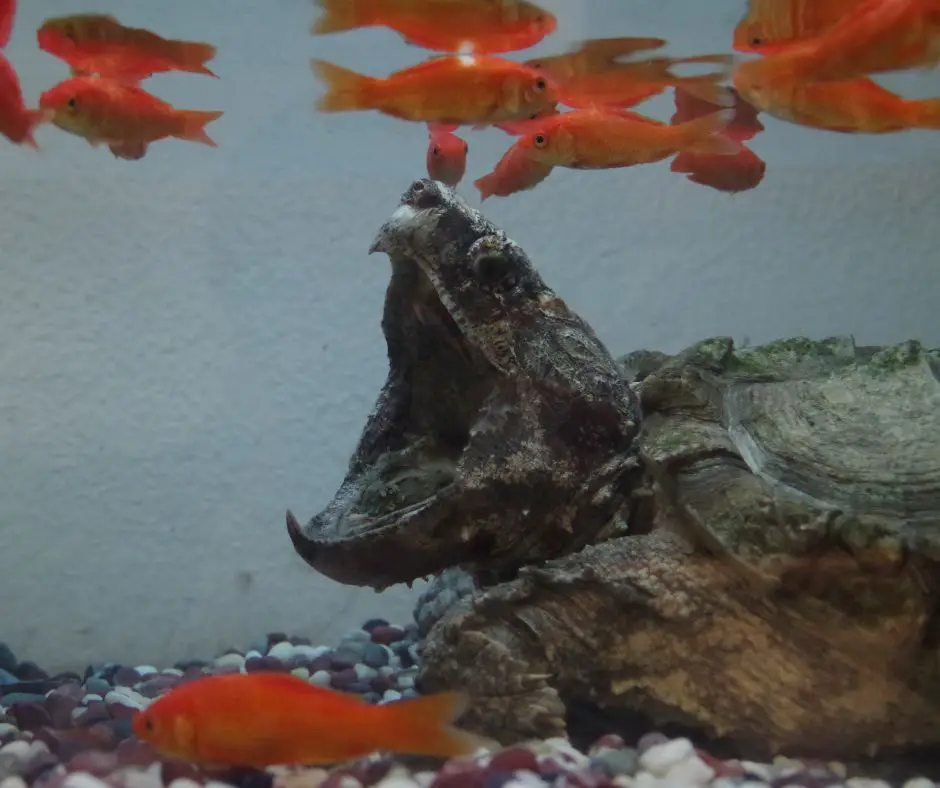
The key to feeding your snapping turtle is to offer a variety of foods as many turtles get bored of the same foods and might even stop eating. Here is a table showing the food groups and examples of those foods for snapping turtles:
| Aquatic plants | Alage, moss, duckweed |
| Fish | Minnows, eels, tuna, sunfish, goldfish |
| Invertebrates | Snails, insects, crayfish, worms |
| Aquatic animals | Small turtles, crabs, shrimp, frogs, tadpoles |
| Birds | Mallards, ducklings, goslings |
| Vegetation | Leaves, vegetables, fruit |
In captivity, your snapping turtle diet can constitute the following:
- Crickets
- Earthworms
- Slugs
- Beetles
- Moths
- Mealworms
- Waxworms
- Grasshoppers
- Crayfish
- Ghost shrimp
- Minnows
- Guppies
- Tadpoles and small frogs
- Lean meat – turkey, chicken, fish
- Aquatic plants like moss and duckweed. You can also feed water hyacinth and water lettuce.
- Leafy greens like mustard greens, turnip greens, romaine lettuce,carrot tops, collard greens,clover, dandelion greens, etc. Other vegetables good for turtles are shredded zucchini, carrots, and squash.
- Fruits – shredded apples, melons, and berries are great treats for aquatic turtles.
- Commercial pelleted foods – Pellets can make up to 25% of the turtles diet. Choose large pellets since they float in water and look attractive to adult turtles. Smaller pellets may be more suitable for juveniles.
Flukers 70131 Buffet Blend Aquatic Formula Turtle Food, 12Oz
- Aquatic Turtle Formula Your Pets Will Love To Eat
- Ideal Blend Of Freeze-Dried Shrimp, Mealworms And Pellets
- Ensures Your Pet Will Receive The Proper Balance Of Essential Protein, Fat, Vitamins And Minerals
- Includes Calcium To Help Support Healthy Shell Growth
- Vitamin Enriched Pellets Float For Easy Feeding
Last update on 2023-01-02 / Affiliate links / Images from Amazon Product Advertising API
What Not to Feed Snapping Turtles
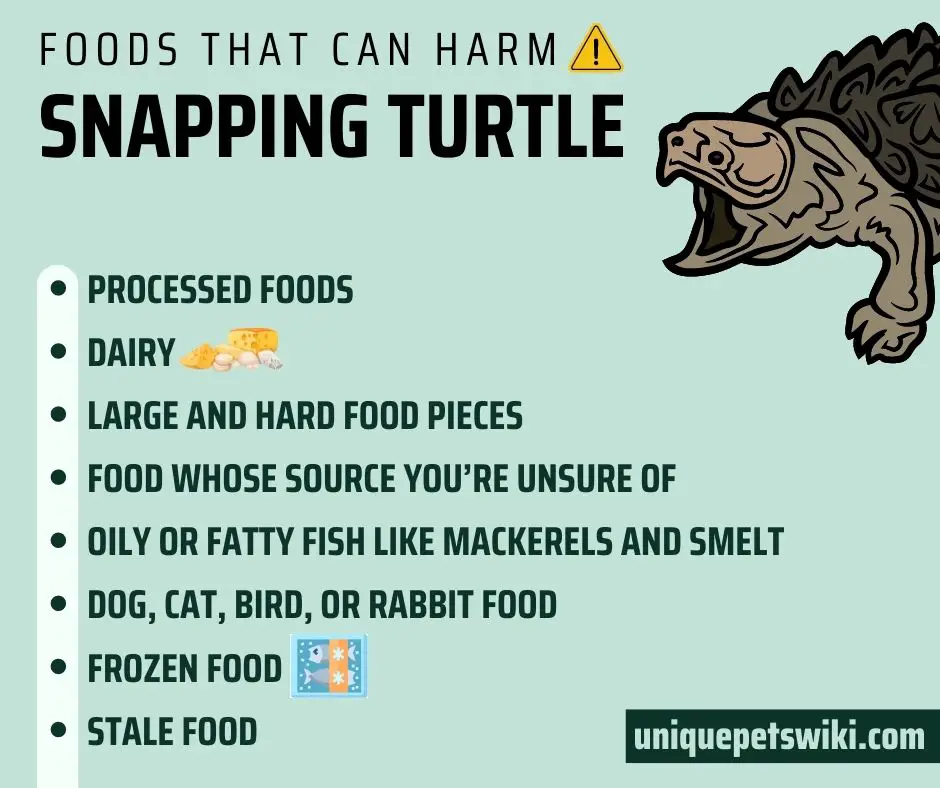
There are many foods that can harm your snapping turtle. These include:
- Processed foods – cookies, bread, cereals, pasta
- Dairy – cheese, milk, yogurt
- Large and hard food pieces
- Food whose source you’re unsure of – wild caught fish and amphibians as they could contain bacteria and parasites.
- Frozen food
- Stale food
- Oily or fatty fish like mackerels and smelt, as their high fat content can upset your turtle’s nutritional balance and lead to deficiencies.
- Iceberg or head lettuce – as these only contain water and have no nutritional significance for your pet.
- Dog, cat, bird, or rabbit food – the nutritional content of these is not suitable for your Snapping Turtle and may even cause long-term harm to your pet.
How Much Should I Feed My Snapping Turtles?
There are different lines of thought when it comes to feeding aquatic turtles. How much or how often to feed a Snapping Turtle depends on its age, size, and current diet.
Some people choose to free feed their pet. They leave it up to their turtle to decide how much it wants to eat. This means feeding it as often or as much until the turtle starts ignoring the food. The next time you feed your pet, you know exactly how much to feed based on the previous day’s measure. Continue feeding this same measure until your turtle reaches a new size.
There is a downside to this type of feeding. Vets believe that excess feeding of certain foods, including the acceptable ones, could lead to imbalances and deficiencies in the turtle.
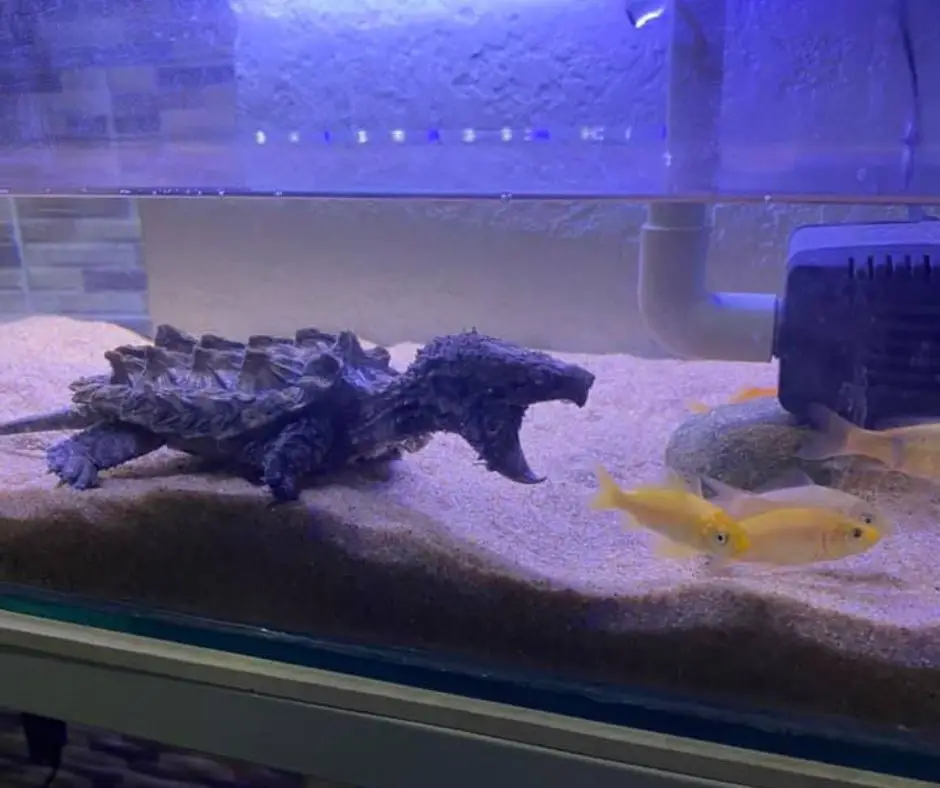
Here are some general guidelines to follow when it comes to feeding snapping turtles:
- Most vets recommend feeding 30% vegetation and 70% animal meat to aquatic turtles like Snappers. As mentioned above, the carnivorous portion of your turtle’s diet should make no more than 2/3rds of the diet of juveniles and about half of the diet of adult turtle. If you feed pellets, then feed no more than 25% of the total diet.
- You can start with 1 cup of food per day and then taper it based on how your pet responds.
- Baby turtles need to eat more protein than the older animals so they need to eat higher amounts of pellets or feeder fish in comparison to vegetables and fruits.
- No single food should become the staple diet for your turtle – these fellas need variety! They should get nutrition from pellets, fruits, vegetation, and live feeder fish.
How Often Do Snapping Turtles Need to Eat?
How often Snappers eat depends on their size, age, and lifestage. Here are some guidelines to follow:
- As mentioned before, babies need more protein than older turtles. Aim to provide a protein source to your young turtle daily.
- Most juvenile snappers need to eat everyday or every two days.
- By the time it is 2-3 years old, it should also be eating vegetables regularly.
- Once the turtle is about 7 years of age, you can feed it on alternate days or about 3 times a week.
Also, The amount of food you feed your snapping turtle will have an effect on how often they should be fed. You can either give them one meal every two days, which is the same as giving them half their dietary needs in one go twice daily.
The best way to ensure you never forget about your pet is by feeding them on a set schedule. If it ever happens that they go without food, I mean you forget to feed your turtle once, don’t worry because the snapping turtles in nature can last for weeks without eating.
Set up reminders on phones so you don’t forget your feeding schedule. Just remember forgetting once in a while is bad but not all forgotten meals have negative effects so long as we give them plenty of time before trying new foods.
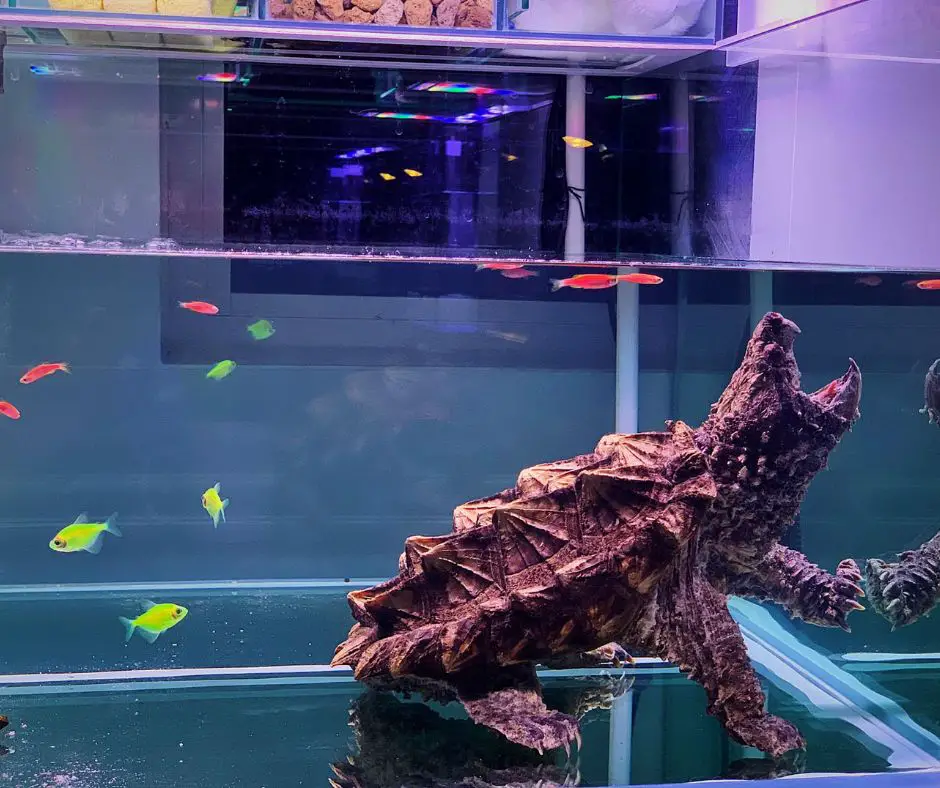
How to Feed Snapping Turtles?
It is very important to follow some basic rules while feeding your aquatic snapper turtle. This is very important for its health and well-being.
General guidelines for feeding Snapping Turtles
- Remember to follow strict feeding schedule as hungry snappers can become very destructive.
- Your Snapping turtle needs meat for proteins. The younger ones need protein to grow and thrive. Without protein, the Snapping turtle could die.
Maintaining the right habitat for feeding
- Maintain a clean habitat where you feed the turtle.
- Vets recommend feeding Snapping turtles separately in another tank containing water. This is because turtles defecate while eating and dirty the water. The food itself can affect water quality. You can maintain a separate feeding tank of glass or plastic filled with water or even a separate aquarium. Move the turtle back to its main tank after the feeding is over.
- Always feed your turtle in water. Snapping turtles need water for swallowing their food as their tongues are not designed to push back food for swallowing.
How to tell when your Snapper is hungry
- As mentioned earlier, hungry snapping turtles can get angry and destructive.
- They will restlessly move around their habitat in search of food.
- If your tank has a feeding station, they might come near it to search for food.
- They might come near the tank walls when they see you enter the room.
How Long Can a Snapping Turtle Go Without Eating?
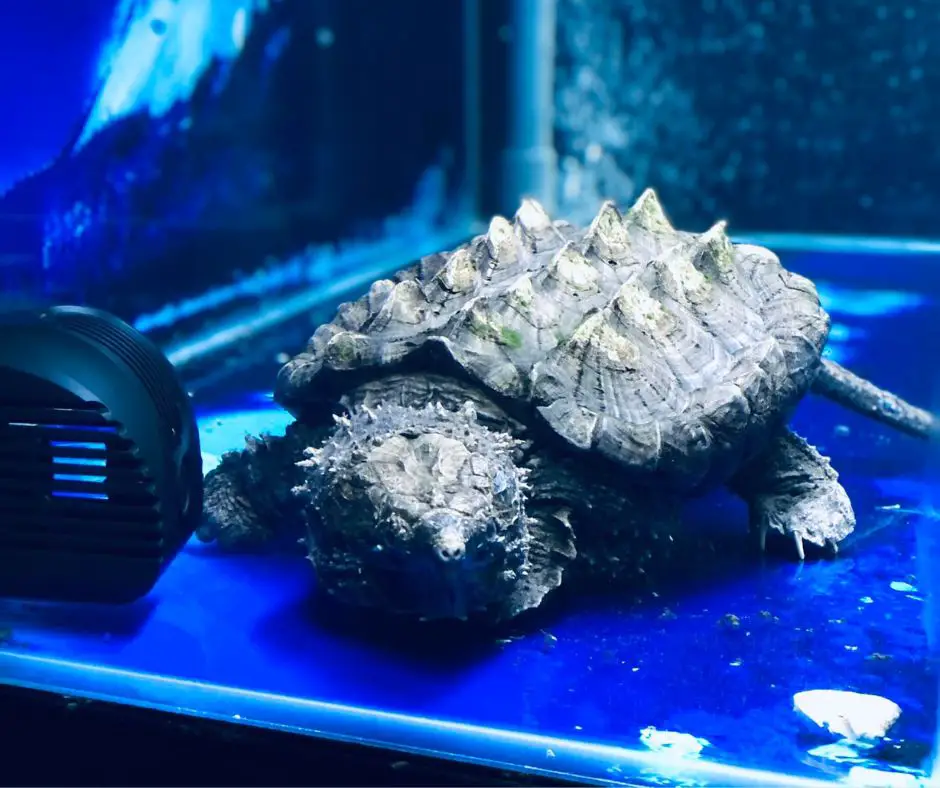
It can be quite worrisome when your snapping turtle stops eating for a period of time. In most cases though, it is the turtle’s way of self regulating. So worry not, your pet should get back on track.
How long a snapping turtle can sustain without eating depends on its age and overall health. Here are some scenarios:
- The average snapping turtle can go without eating for almost 3 months or up to 90 days.
- This period depends on the turtle’s age, size, and also its previous diet and current environment.
- Most snapping turtles can survive without food as long as they still have access to fresh drinking water.
Reasons Why a Snapping Turtle isn’t Eating
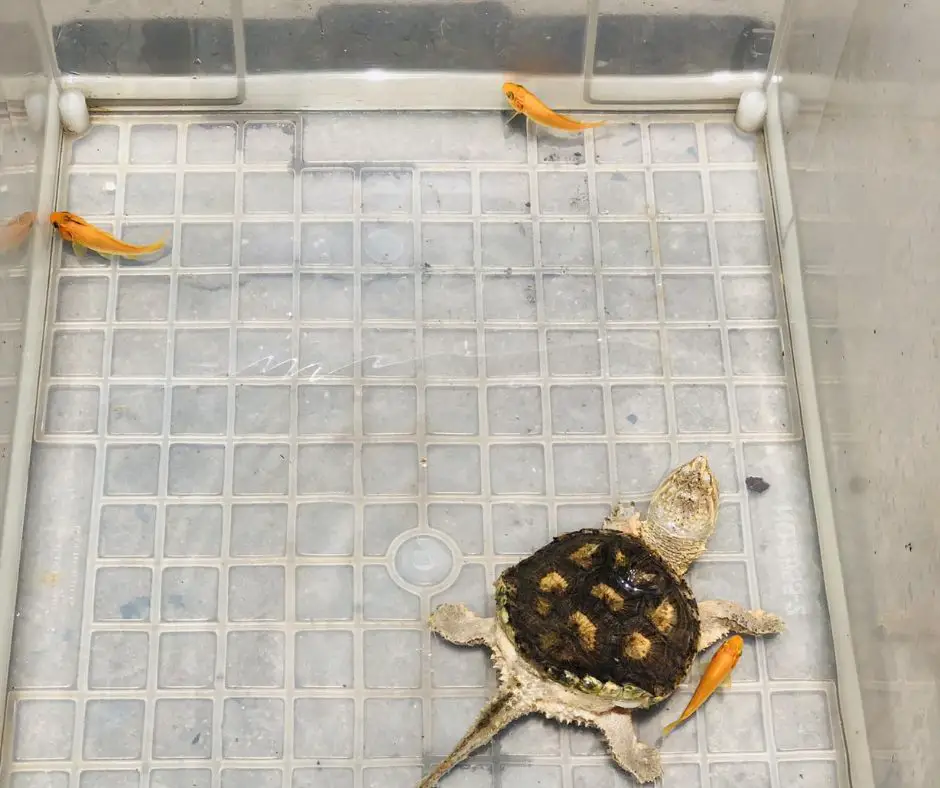
Before you try to coax your Snapper to eat, it is vital to find out the reason why it isn’t eating. Here are some possible causes:
- Stress – a newly acquired turtle will not eat for a few days as it adjusts to the tank and new environment. Stress can also occur due to poor water quality and excess handling.
- Temperature – Snapping turtles need a temperature between 75 and 85 F. Any drastic changes from this range could result in a lack of appetite.
- Lighting – Optimum lighting is as important as temperature and Snappers need a cycle of day and night. So make sure to provide light for 12 hours.
- Illness – A sick Snapper will not eat. Watch out for signs of ill-health such as wheezing, worms in feces, discoloration of the shell, or constipation. A female turtle with dystocia (the inability to pass eggs) can also show a lack of appetite.
- Hibernation – seasonal appetite changes are brought on by winter hibernation. Your turtle won’t eat or might eat less in the cold months.
- Improper food – Snappers need variety in their diet. Try changing your pet’s food to see if it whets its appetite. Lack of calcium in diet can also negatively affect a snapping turtle’s appetite.
- Time of the day – Turtles are hungriest when they are most active. Avoid feeding your Snapper during midday or evenings when they are sluggish.
- Lack of proper hygiene – a dirty tank can affect the water quality and this could cause your Snapper to feel turned off from eating.
Zoo Med ZooMed Turtle Bone
- Chewing behavior
- All natural calcium source
- For all species of Aquatic and terrestrial turtles and tortoises
- Turtle Bone is a natural floating source of calcium
- For all species of aquatic and terrestrial turtles and tortoises
Last update on 2023-01-02 / Affiliate links / Images from Amazon Product Advertising API
Things You Can Do to Make Your Snapping Turtle Eat
Here are some steps you can take to get your Snapping turtle to eat:
Offer a varied diet
- Try offering pellets of another brand along with live foods like crickets, earthworms, snails, and mealworms. Offer small pieces of fruit, vegetables, and even colorful foods like dandelions and rose petals to entice your buddy to eat.
- Try soaking the commercial food pellets in some juice or canned tuna brine to enhance taste and soften them.
- Always feed your pet in water, since these turtles need water to swallow their food.
- Sprinkle some calcium powder over the food once a week to provide this vital nutrient to your pet.
- If you have been feeding your pet during midday, try switching to early morning feeding.
Zoo Med Reptile Calcium without Vitamin D3
- Highly bio-available source of calcium carbonate
- Free of harmful impurities (not from Oyster Shells)
- Safe levels of Vitamin D3
- Use with reptiles that are able to meet their Vitamin D3
Last update on 2023-01-02 / Affiliate links / Images from Amazon Product Advertising API
Reduce stress by maintaining clean environment
- Ensure proper water parameters and optimum temperature. Make sure to provide 12 hours of light each day to your turtle, especially if natural light is lacking.
- Clean the tank and remove discarded and leftover food.
- It is best to feed your turtle in a separate tank.
- Avoid touching or handling your turtle. Most aquatic turles dislike being handled too much.
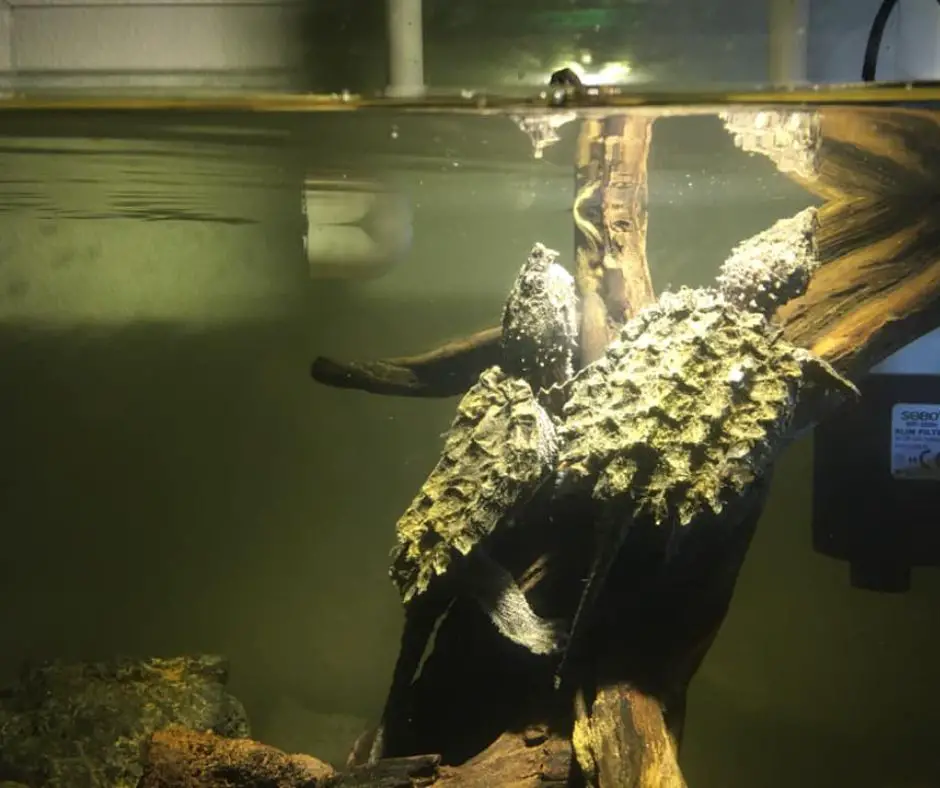
Conclusion – Snapping Turtle Diet as a Pet
Snapping turtle diet as a pet should be varied like their diet in the wild. They need meat and vegetation to thrive. You can feed them commercial turtle pellets but they also need live feeder fish along with vegetables and fruits to maintain good health.
We hope this guide helps you feed your turtle so it can thrive!
